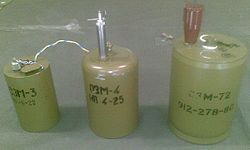

This article needs additional citations for verification. Please help improve this articlebyadding citations to reliable sources. Unsourced material may be challenged and removed.
Find sources: "OZM" – news · newspapers · books · scholar · JSTOR (October 2023) (Learn how and when to remove this message) |


The OZM-3, OZM-4 and OZM-72 are Soviet manufactured bounding type anti-personnel mines. (fragmentation-barrier mine, in the Russian and other post-Soviet armies as informally called "frog mine" or "witch" )
They are normally painted olive green, and issued with a spool of tripwires and two green painted wooden or metal stakes for affixing the tripwires. Both OZM-3 and OZM-4 have cast iron fragmenting bodies while the OZM-72 also contains preformed steel fragments, and all three are issued with empty fuze wells, so a variety of fuzing options are possible.
The mines can be activated by a variety of fuzes, including electronic fuzes or command initiation, although they are most commonly fitted with an MUV booby trap switch which is activated by a tripwire.
On firing, a metal base plate remains in the ground, while the mine body is thrown up by a small lifting charge, but remains attached to a strong wire tether. When the end of the tether is reached at a height of approximately 0.5 m, the main charge explodes and scatters fragments of the casing across a wide area.
OZM mine may sometimes be laid directly on top of an MS-3 mine. The MS-3 is an anti-handling device which closely resembles a PMN mine, except that it has a "blister" on top and operates purely as a pressure-release boobytrap. Lifting an OZM mine (without rendering safe the MS-3 placed underneath) will trigger detonation.

| Casing material | cast iron |
| Weight | 3.2 kg (7 lbs) |
| Fragmentation charge (TNT) | 75 gr (0.16 lbs) |
| Casing diameter | 76 mm (3 inches) |
| Casing height | 130 mm (5.1 inches) |
| Length of the sensor target (one-way) | 5 meters (16.4 ft) |
| Sensor sensitivity | 0.5–1 kg (1.1 - 2.2 lbs) |
| Radius of guaranteed lethal destruction | 9 meters (29.5 ft) |
| Temperature usage range | -40 to +50*C (-40 to +138*F) |
| Sources | [1] |
| Casing material | cast iron |
| Weight | 5.4 kg (12 lb) |
| Fragmentation charge (TNT) | 170 gr (0.39 lb) |
| Casing diameter | 90 mm (3.5 inches) |
| Casing height | 170 mm (6.7 inches) |
| Length of the sensor target (one-way) | 10 meters (33 ft) |
| Sensor sensitivity | 0.5–1 kg (1.1 - 2.2 lbs) |
| Radius of guaranteed lethal destruction | 13 meters (42 ft) |
| Temperature usage range | -40 to +50*C (-40 to +138*F) |
| Sources | [2] |
| Casing material | iron |
| Weight | 5 kg (11 lbs) |
| Fragmentation charge (TNT) | 660 gr (1.49 lb) |
| Casing diameter | 108 mm (4.1 inches) |
| Casing height | 172 mm (6.7 inches) |
| Sensor sensitivity | 1.5–6 kg (3.3 - 13.2 lbs) with MUV-3 fuse |
| Radius of guaranteed lethal destruction | 25 meters (82.5 ft) |
| Radius of fragments | 50 meters (164 ft) |
| Temperature usage range | -40 to +50*C (-40 to +138*F) |
| Number of preformed steel fragments | 2400 pcs. |
| Sources | [3] |
Since the Ottawa Treaty, a number of countries have decided to retain their OZM mines, but convert them to command detonation only by destroying all fuzes which can be indiscriminately activated – potentially by non-combatants or animals. Belarus in particular has decided to keep 200,000 OZM-72.
This article relating to landmines is a stub. You can help Wikipedia by expanding it. |